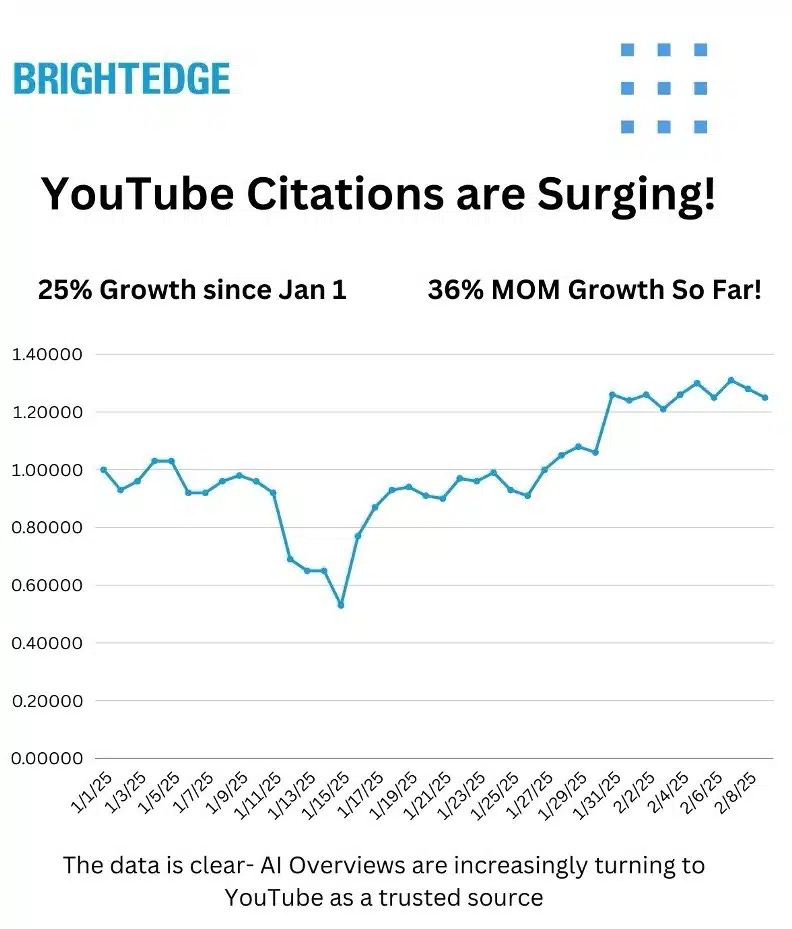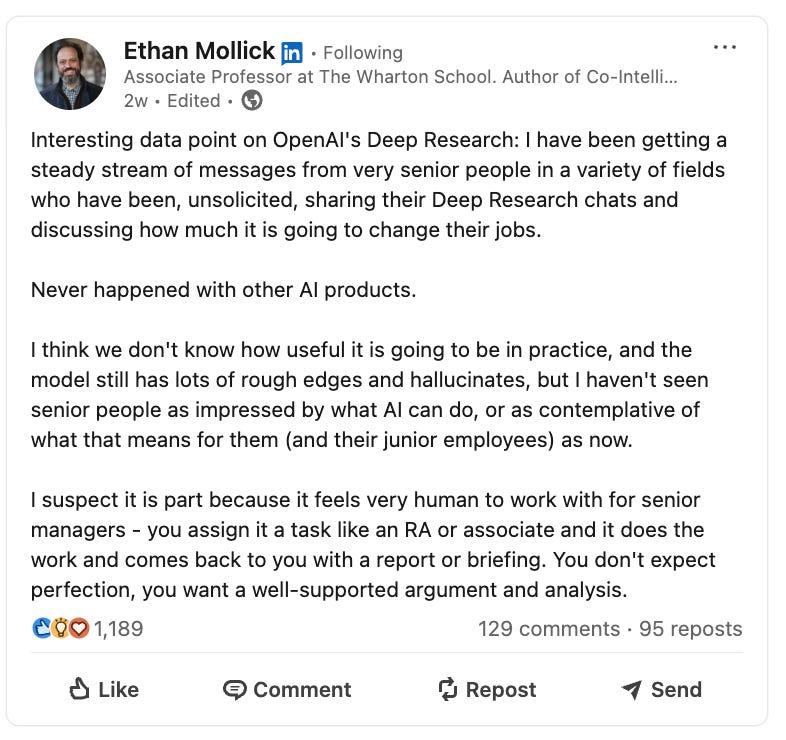Buying committees and LLMs: the two audience groups that matter today
How to build product marketing programs that serve both groups, value and context.
One day, I will stick to publishing every week (probably when I’m not juggling my son’s pre-k winter break and his siblings’ colds 😅). Till then, I’m happy you’re still choosing to join me by reading The 100.
Now to the world of B2B.
Albert Szent-Györgyi was a Hungarian biochemist who made significant contributions to the fields of biological oxidation, vitamin C research, and muscle biochemistry. He once said “Research is to see what everybody else has seen, and to think what nobody else has thought.” This week I’ve spent too many hours running different deep research reports on Perplexity and for the first time since GenAI went mainstream, I can now see some of the rapid pivots this type of technology will demand of enterprise marketers today.
That led me to getting excessively curious in how I asked a couple of revenue marketing leaders about the tactics they use for buyer identification and ICP building. I wanted to know more about they are learning about how their audiences research. Because deep research, WILL phenomenally change how B2B audiences research.
Some teams use dynamic data orchestration - combining real-time sales, marketing, and product signals in various platforms.
Others focus on engagement patterns, watching how different stakeholders interact with different content on various platforms to inform presumptions about lifecycle stages.
Some still stick to standard demographic data, industry targets, and role-based personas.
Tools such as Clay, 6sense and DemandBase were mentioned amongst others as more data enrichment platforms become integral to sophisticated ABM motions.
But here's the critical blind spot I’m seeing pop up the most across all three: Your ICP should map how buying committees actually collaborate and reach decisions, from individual role to committee-wide consensus.
Most teams document individual roles perfectly while missing the committee dynamics that drive actual purchases. It's like having detailed player stats but no understanding of how the team wins games together.
This collaboration intelligence, knowing exactly how different stakeholders influence each other, is what separates high-growth GTM from siloed, stagnant marketing.
Changing buying committees and AI make way for a new approach to content creation
B2B purchases are hardly ever decided by just one person. By now we know that a multi-function group researching, evaluating, and reaching consensus across both individual role priorities and organizational needs, is what moves the needle. While understanding individual roles helps create relevant outreach, mapping how these roles collaborate to reach consensus has even greater impact on your growth trajectory.
This shift in committee dynamics brings three converging changes that are becoming harder to ignore:
1. ICPs deliver real value when they map entire committee dynamics. Not just individual roles, but how these roles work together to reach decisions.
2. Executive stakeholders are increasingly using AI to conduct deeper, faster research and with the emergence of deep research, that behavior will be accelerate in 2025.
3. As a result, modern content must serve two audiences simultaneously: human buying committees and their AI research tools. Each piece of content needs to deliver value to human readers while providing structured data that AI systems can accurately analyze when answering specific queries.
For content teams, this means reimagining your entire content approach. Every asset must work harder - delivering clear value to human readers while being structured for AI analysis and synthesis. That means, in your GTM narratives, your product experience must serve multiple perspectives while maintaining a unified narrative.
Here are three ways to get started.
1. Building a technical foundation for dual-audience context
Modern B2B content serves two audiences simultaneously: buying committees and AI systems. Think of it like building a smart home - beautiful and functional for residents, but also equipped with intelligent systems that make everything work better.
Three strategic elements:
Smart structure design: Map your content to real buying patterns. When a CTO searches for scalability metrics or a CISO needs compliance details, they need to find contextual answers instantly. Each piece of content becomes a bridge between technical capabilities and business decisions. Technical implementation includes things like:
Using clear schema markup (FAQPage, HowTo)
Structuring data for both AI indexing and human reading
Connecting technical specs to business outcomes
Content building blocks: Break complex topics into 50-150 word segments. You can also leverage tools like SurferSEO's Content Editor which can help identify optimal structures that work for both AI search platforms and human readers.
Rich media enhancement: With 95% of B2B buyers saying video plays an important role in deciding to move forward with a purchase, your media strategy should include:
Adding timestamped transcripts for AI indexing
Creating chapter markers aligned to buying stages
Designing clear navigation paths between related content
Not to mention, attached chart further underscores the growing influence of video in the online research journey. As shown, YouTube citations have surged by 25% since January and experienced 36% month-over-month growth in Google’s AI overviews.

2. Modern content teams: the four essential roles that are central to productivity
Think of your modern content team as a newsroom that covers both the mundane and the breaking news. Every story needs multiple experts, working in sync. Both sides, urgent and mundane, has due priority.
Product marketing: They spend time in sales calls and customer conversations, mapping real challenges to product capabilities. Their focus shifts from crafting standalone messaging to building frameworks and use cases that resonate with both technical users and executive influencers in a buying committee. Each insight is charged with shaping how product experiences connect meaningfully to business outcomes.
Technical writers: Complex product features become clear, structured documentation. Like LEGO instruction manuals for enterprise software - precise, clear, infinitely connectable. Each piece fits perfectly with the next but sits further down in the journey when developing audience trust is a big responsibility of this type of content.
Content designers: They break big ideas into flexible assets. The days of taking your blog banner and posting it to every social media channel have come to an end. A social media post takes the audience to a technical white paper that connects to an ROI calculator that leads to implementation guides. When you’re designing asset mixes, you’re designing and creating an ecosystem of digital experiences. Different ‘feels’ and learning paths, for the many roles and affinities of your dynamic buying committees.
AIO analysts: This is the future role of today’s SEO practitioner. They track how different content structures perform in generative AI results, test query patterns, and ensure key product details surface consistently. When a CTO asks ChatGPT about scalability options or a CFO searches for ROI calculators, AIO analysts make sure your solutions appear at the right moment with the right details. Think of them as visibility architects, building pathways for your content to reach committees regardless of how they search.
3. Practical measurement in 2025: what's actually possible
When it comes to effective measurement of AI search the only person I’d really pay attention to is Rand Fishkin. I’ve followed him for about 6+ years and one thing he brings to this space is objectivity. He recently shared his thoughts on a recent Datos report on AI search trends and the below graph stood out in supporting what I’ll suggest in this section.
AI response monitoring: start simple
The growing adoption of AI platforms (with ChatGPT leading at 20+% user adoption in 2024) means your content increasingly appears in AI-generated responses. Monitor this with:
A simple spreadsheet tracking 5 key product queries
Weekly tests in ChatGPT and other growing platforms like Perplexity and Gemini
Documentation of which product details appear consistently
Notes on competitor mentions and comparisons
As the graph shows, multiple AI platforms are gaining traction, so consider expanding your testing beyond just ChatGPT, especially those AI platforms being mentioned on your sales and partner discovery calls.
Content testing: focus on format effectiveness
This requires manual effort but delivers valuable insights:
Create two versions of the same product information
Test both in AI systems with identical queries
Note which format gets more accurate representation
Use these learnings for future content creation
See it in action:
Let’s say a B2B SaaS company tested two different ways of presenting their API capabilities:
Format A: Technical specification list
API rate limits: 100 requests/second
Authentication: OAuth 2.0 and API keys
Response time: <200ms for 95% of requests
Data formats: JSON, XML
Documentation: Interactive Swagger UIFormat B: Problem-solution structure
Challenge: Development teams struggle with rate limiting
Solution: Our API handles 100 requests/second with consistent <200ms response time
Challenge: Security implementation slows projects
Solution: Simple OAuth 2.0 and API key options with ready-to-use code examples
Challenge: Documentation quality impacts adoption
Solution: Interactive Swagger UI with live testing capabilityHypothetical outcome:
When tested with the query "What are [Product]'s API capabilities?" in ChatGPT:
Format A appeared in 40% of responses with technical details accurately cited
Format B appeared in 75% of responses with both technical details AND business benefits mentioned
These types of outcomes may drive decisions like the company now choosing to structure all technical documentation with this problem-solution format, resulting in more accurate representation in AI responses and higher engagement from both technical and business stakeholders.
If you create a simple spreadsheet tracking top customer/buyer queries for 30 days, the patterns you spot can become a starting point for meaningful optimization. Start simple, stay consistent, and build on what works.
2026 is the year we see this in action.
By 2026, I strongly believe agentic AI will start to reshape how buying committees conduct vendor research and achieve consensus. Think of it like having a super-smart research assistant for every executive decision maker. These AI helpers will automatically connect the dots between everyone's needs via internal agent networks, serving up solutions that actually make sense for the whole team. We’re already seeing demos of this today.
Individual and role-specific criteria will no longer hold decisions back, but rather provide the ideal parameters for getting super specific on solutions that make the most sense for them, and the wider org. We'll hopefully say goodbye to endless meetings trying to get everyone on the same page. Teams will be able to focus on the strategic stuff that really matters but then I imagine there will be an organizational culture fallout from this change in the way we work, something we’ll explore another time.
So coming back to what this means for your content team today:
Start building your dual-audience content foundation now
Be open to evolving your content team structure to support AI readiness and constantly changing dynamics in SaaS buying committees
Focus on metrics that matter, for both human and AI discovery
The buying committee of 2026 will be more connected, more informed, and more AI-enabled than ever. This change is coming, there’s no denying that. The real question it's whether your content strategy will be ready when it arrives.
Till next time,✌🏼
Cheers,
Chae







